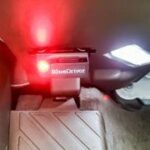Adding a heads-up display (HUD) to your vehicle significantly enhances the driving experience by projecting crucial information onto the windshield. This guide delves into the intricacies of wiring a Gator Heads Up Obd2 Hud Display, specifically focusing on leveraging existing wiring harnesses for a cleaner installation. We’ll outline the necessary components, connector details, and terminal specifications required for a successful DIY installation.
Understanding the Wiring Schematic
While this guide draws inspiration from the Chevrolet SS HUD wiring diagram, the principles apply broadly to various vehicles. The core concept revolves around tapping into existing power, ground, and data connections to minimize the need for extensive modifications.
Key connections required for the Gator Heads Up OBD2 HUD display include:
- P29: Connection to the HUD display unit.
- S27: Connection to the HUD dimmer control switch.
- X252: Power and ground source (often utilized for the shifter harness).
- JX200: Data line connection point (typically located behind the glove box).
- Headlight Switch Harness: Connection for the LED backlight control (not depicted in the diagram).
Connector and Terminal Specifications
P29: HUD Display Module Connector
The P29 connector, often an Aptiv (formerly Delphi) part number 15499368, interfaces with the HUD display unit.
This connector utilizes specific terminals, which can be challenging to source. While the original Aptiv 15491265 might be obsolete, compatible Yazaki Kaizen 0.64 Micros Female terminals (suitable for 20-22 AWG wire) can be viable alternatives. Alternatively, JST SAIT-A02T-M064 terminals have been confirmed to work.
S27: HUD Dimmer Switch Connector
The S27 connector, typically a JST HCM series connector (HCMPB-06-K without Connector Position Assurance or HCMPB-C06A-K with CPA), connects to the dimmer switch.
This connector accepts JST SHCM-A03T-P025 female terminals, suitable for 20-22 AWG wire.
JX200: Data Line Connection
The JX200 connector, often referred to as a splice pack, serves as a central hub for the vehicle’s data network. Adding the HUD’s data line involves inserting a terminal into an open slot within this connector.
Recommended terminals include Aptiv GT 150 Series female terminals (e.g., 12191812 for up to 18 AWG wire or 12191811 for smaller gauge wires like 22 AWG).
LED Backlight Control
The SS diagram lacks a designated connector for the LED backlight. A practical solution involves tapping into the headlight switch harness using a Posi-tap connector, placing the dimmer switch conveniently nearby.
Conclusion
Successfully integrating a Gator Heads Up OBD2 HUD display requires careful planning and execution. By understanding the wiring schematic and utilizing the provided connector and terminal information, enthusiasts can confidently tackle this DIY project. Remember to consult your vehicle’s specific wiring diagrams for accurate pinouts and connector locations. This guide provides a solid foundation for a clean and efficient installation, minimizing the need for extensive modifications while maximizing driving enjoyment.

